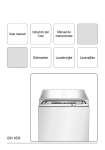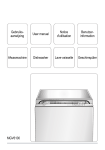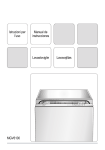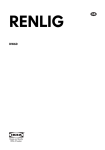Download Gebruiks- aanwijzing Afwasmachine User manual Dishwasher
Transcript
Gebruiksaanwijzing
User manual
Notice
d'utilisation
Benutzerinformation
Afwasmachine
Dishwasher
Lave-vaisselle
Geschirrspüler
MGV6100
20
Contents
Safety information
Product description
Control panel
Use of the appliance
Setting the water softener
Use of dishwasher salt
Use of rinse aid
Loading cutlery and dishes
Use of detergent
Multitab function
20
21
22
23
23
25
25
26
28
29
Setting and starting a washing programme
30
Washing programmes
31
Care and cleaning
32
What to do if…
33
Technical data
34
Installation
35
Water connection
35
Electrical connection
36
Environment concerns
36
Subject to change without notice
Safety information
For your safety and correct operation of
the appliance, read this manual carefully
before installation and use. Always keep
these instructions with the appliance
even if you move or sell it. Users must
fully know the operation and safety features of the appliance.
Correct use
• The appliance is designed exclusively for
domestic use.
• Only use the appliance to clean household
utensils that are applicable for dishwashers.
• Do not put solvents in the appliance. Risk
of explosion.
• Put the knives and all items with sharp
points in the cutlery basket with their
points down. If not, put in a horizontal position in the upper basket.
• Use only branded products for dishwashers (detergent, salt, rinse aid).
• If you open the door while the appliance is
in operation, hot steam can escape. Risk
of skin burns.
• Do not remove dishes from the dishwasher
before the end of the washing programme.
• When the washing programme is completed, disconnect the mains plug from the
mains socket and close the water tap.
• Only an authorised service engineer can
repair this appliance. Use only original
spare parts.
• Do not do repairs yourself to prevent injury
and damage to the appliance. Always contact your local Service Force Centre.
General safety
• Persons (including children) with reduced
physical sensory, mental capabilities or
lack of experience and knowledge must
not use the appliance. They must have supervision or instruction for the operation of
the appliance by a person responsible for
their safety.
• Obey the safety instructions from the manufacturer of the dishwasher detergent to
prevent burns to eyes, mouth and throat.
• Do not drink the water from the dishwasher. Detergent residues can stay in your appliance.
• Always close the door when you do not
use the appliance to prevent injury and not
to stumble over the open door.
• Do not sit or stand on the open door.
Child safety
• Only adults can use this appliance. Children must get supervision to make sure
that they do not play with the appliance.
• Keep all the packaging away from children.
There is a risk of suffocation.
• Keep all detergents in a safe area. Do not
let children touch the detergents.
• Keep children away from the appliance
when the door is open.
Installation
• Make sure that the appliance is not damaged because of transport. Do not connect a damaged appliance. If necessary,
contact the supplier.
• Remove all packaging before first use.
21
• A qualified and competent person must do
the electrical installation.
• A qualified and competent person must do
the plumbing installation.
• Do not change the specifications or modify
this product. Risk of injury and damage to
the appliance.
• Do not use the appliance:
– if the mains cable or water hoses are
damaged,
– if the control panel, worktop or plinth
area are damaged, that you can get access to the inner side of the appliance.
Contact your local Service Force Centre.
• Do not drill into the sides of the appliance
to prevent damage to hydraulic and electrical components.
Warning! Carefully obey the
instructions for electrical and water
connections.
Product description
1
2
3
4
5
Upper basket
Water hardness dial
Salt container
Detergent dispenser
Rinse aid dispenser
6
7
8
9
Rating plate
Filters
Lower spray arm
Upper spray arm
22
Control panel
1
3
2
A
B
C
D
4
E
5
1
2
3
4
5
On/off button
Programme selection buttons
Delay start button
Indicator lights
Function buttons
Indicator lights
Salt 1)
Comes on when it is necessary to fill the salt container.
Refer to the chapter 'Use of dishwasher salt'.
After you fill the container, the salt indicator light can continue to stay on for some hours. This does not have an
unwanted effect on the operation of the appliance.
Multitab
Comes on when you activate the multitab function. Refer
to the chapter 'Multitab function'.
End-of-programme
Comes on when the washing programme is completed.
Auxiliary functions:
• Level of the water softener.
• Activation/deactivation of the audible signals.
• Activation/deactivation of the rinse aid dispenser.
• An alarm if the appliance has a malfunction.
1) When the salt container is empty, the related indicator light does not come on while a washing
programme operates.
Programme selection buttons
With these buttons you can select the washing programme. Press a programme button,
the related indicator light comes on. Refer to
'Washing programmes' chapter for more data about the washing programmes.
Delay start button
Use the delay start button to delay the start
of the washing programme with an interval of
3, 6 or 9 hours. Refer to the chapter 'Setting
and starting a washing programme'.
Function buttons
Use the function buttons for these operations:
• To set the water softener. Refer to the
chapter 'Setting the water softener'.
• To deactivate/activate the audible signals.
Refer to the section 'Audible signals'.
• To activate/deactivate the multitab function. Refer to the chapter 'Multitab function'.
• To deactivate/activate the rinse aid dispenser when multitab function is active.
Refer to the chapter 'Multitab function'.
23
• To cancel the washing programme in progress or a delay start in progress. Refer to
the chapter 'Setting and starting a washing
programme'.
Setting mode
The appliance must be in setting mode for
these operations:
• To set a washing programme.
• To set the water softener level.
• To deactivate/activate the audible signals.
• To deactivate/activate the rinse aid dispenser.
Press the on/off button. The appliance is in
setting mode when:
• All the programme indicator lights come
on.
Press the on/off button. The appliance is not
in setting mode when:
• Only one programme indicator light comes
on.
• A washing programme is set. It is necessary to cancel the programme to go back
to the setting mode. Refer to the chapter
'Setting and starting a washing programme'.
Audible signals
You can hear an audible signal:
• At the end of the washing programme.
• During the setting of the level of the water
softener.
• When the appliance has a malfunction.
The activation of the audible signals is set at
the factory.
Do these steps to deactivate the audible signals:
1. Switch on the appliance.
2. Make sure that the appliance is in setting
mode.
3. Press and hold function buttons B and C
until the indicator lights of function buttons A, B and C start to flash.
4. Press the function button C.
– Indicator lights for function buttons A
and B go off.
– Indicator light for function button C
starts to flash.
– The end-of-programme indicator light
comes on.
The audible signals are activated.
5. Press the function button C again.
– The end-of-programme indicator light
goes off.
The audible signals are deactivated.
6. Switch off the appliance to save the operation.
Do these steps to activate the audible signals:
1. Do the above procedure until the end-ofprogramme indicator light comes on.
Use of the appliance
Refer to the following instructions for each
step of procedure:
1. Make a check if the water softener level
is correct for the water hardness in your
area. If necessary set the water softener.
2. Fill the salt container with dishwasher salt.
3. Fill the rinse aid dispenser with rinse aid.
4. Load cutlery and dishes into the dishwasher.
5. Set the correct washing programme for
the type of load and soil.
6. Fill the detergent dispenser with the correct quantity of detergent.
7. Start the washing programme.
If you use combi detergent tablets ('3 in
1', '4 in 1', '5 in 1', etc.), refer to the
chapter 'Multitab function'.
Setting the water softener
The water softener removes minerals and
salts from the water supply. Minerals and
salts can have bad effect on the operation of
the appliance.
Water hardness is measured in equivalent
scales:
• German degrees (dH°).
• French degrees (°TH).
• mmol/l (millimol per litre - international unit
for the hardness of water).
• Clarke.
24
Adjust the water softener to the water hardness in your area. If necessary, contact your
local water authority.
Water hardness
Water hardness setting
°dH
°TH
mmol/l
Clarke
manually
electronically
51 - 70
91 - 125
9,1 - 12,5
64 - 88
2
10
43 - 50
76 - 90
7,6 - 9,0
53 - 63
2
9
37 - 42
65 - 75
6,5 - 7,5
46 - 52
2
8
29 - 36
51 - 64
5,1 - 6,4
36 - 45
2
7
23 - 28
40 - 50
4,0 - 5,0
28 - 35
2
6
19 - 22
33 - 39
3,3 - 3,9
23 - 27
2
5
15 - 18
26 - 32
2,6 - 3,2
18 - 22
1
4
11 - 14
19 - 25
1,9 - 2,5
13 - 17
1
3
4 - 10
7 - 18
0,7 - 1,8
5 - 12
1
2
<4
<7
< 0,7
<5
11)
11)
1) No use of salt required.
You must set the water softener manually and electronically.
Manual adjustment
The appliance is set at the factory at position 2.
1. Open the door.
2. Remove the lower basket.
3. Turn the water hardness dial to position
1 or 2 (refer to the chart).
4. Install the lower basket.
5. Close the door.
Electronic adjustment
The water softener is set at the factory
at level 5.
1. Switch on the appliance.
2. Make sure that the appliance is in setting
mode.
3. Press and hold function buttons B and C
until the indicator lights for function buttons A, B and C start to flash.
4. Release function buttons B and C.
5. Press function button A.
– The indicator light for function button A
continues to flash.
– The indicator lights for function buttons
B and C go off.
– The end-of-programme indicator light
starts to flash.
– You can hear an audible signal.
The setting function of the water softener
is activated.
The end-of-programme indicator light
flashes and an audible signal operates to
show the level of the water softener. The
pause is approximately 3 seconds.
Example: 5 flashes / 5 intermittent audible
signals - pause - 5 flashes / 5 intermittent
audible signals - pause - etc. = level 5
6. Press the function button A one time to
increase the water softener level by one
step.
7. Press the on/off button to save the operation.
25
Use of dishwasher salt
Caution! Only use dishwashers salt.
Types of salt that are not applicable for
dishwashers cause damage to the water
softener.
Caution! Grains of salt and salty water
on the bottom of the appliance can
cause corrosion. Fill the appliance with
salt before you start a washing
programme to prevent corrosion.
Do these steps to fill the salt container:
1. Turn the cap anticlockwise to open the
salt container.
2. Fill the salt container with 1 litre of water
(only the first operation).
3. Use the funnel to fill the salt container with
salt.
Use of rinse aid
Caution! Only use branded rinse aid for
dishwashers.
Do not fill the rinse aid dispenser with
other products (e.g. dishwasher cleaning agent, liquid detergent). This can
cause damage to the appliance.
Rinse aid makes it possible to dry the
dishes without streaks and stains.
Rinse aid is automatically added during
the last rinsing phase.
Do these steps to fill the rinse aid dispenser:
1. Press the release button (A) to open the
rinse aid dispenser.
4. Remove the salt around the opening of
the salt container.
5. Turn the cap clockwise to close the salt
container.
It is normal that water overflows from the
salt container when you fill it with salt.
When you set electronically the water softener to level 1, the salt indicator light does
not stay on.
26
2. Fill the rinse aid dispenser with rinse aid.
The mark 'max.' shows the maximum
level.
3. Remove the spilled rinse aid with an absorbent cloth to prevent too much foam
during the subsequent washing programme.
4. Close the rinse aid dispenser.
Fill the rinse aid dispenser when the rinse aid
indicator (B) becomes clear.
Adjusting the rinse aid dosage
The rinse aid is set at the factory at position
4.
You can set the rinse aid dosage between
position 1 (lowest dosage) and position 6
(highest dosage).
1. Turn the rinse aid dial to increase or decrease the dosage.
– Increase the dosage if there are water
droplets or limescale on the dishes.
– Decrease the dosage if there are
streaks, whitish stains or bluish layers
on the dishes.
Loading cutlery and dishes
Helpful hints and tips
Caution! Only use the appliance for
household utensils that are applicable
for dishwashers.
Do not use the appliance to clean objects
that can absorb water (sponges, household
cloths, etc.).
• Before you load cutlery and dishes, do
these steps:
– Remove all food remainings and debris.
– Make burnt, remaining food in pans soft.
• While you load cutlery and dishes, do
these steps:
– Load hollow items (e.g. cups, glasses
and pans) with the opening down.
– Make sure that water does not collect in
the container or in a deep base.
– Make sure that cutlery and dishes do not
lie inside one another.
27
– Make sure that cutlery and dishes do not
cover other cutlery and dishes.
– Make sure that glasses do not touch
other glasses.
– Put small objects in the cutlery basket.
• Plastic items and pans with non-stick
coatings can keep water droplets. Plastic
items do not dry as well as porcelain and
steel items.
• Put light items in the upper basket. Make
sure that the items do not move.
Caution! Make sure that the spray arms
can move freely before you start a
washing programme.
Warning! Always close the door after
you load or unload the appliance. An
open door can be dangerous.
Lower basket
Put saucepans, lids, plates, salad bowls and
cutlery in the lower basket. Arrange service
dishes and large lids around the edge of the
basket.
Cutlery basket
Warning! Do not put long-bladed knives
in a vertical position. Arrange long and
sharp cutlery horizontally in the upper
basket. Be careful with sharp items.
Put forks and spoons with the handles down.
Put knives with the handles up.
Mix spoons with other cutlery to prevent
them to bond together.
Use the cutlery grid. If the dimensions of the
cutlery prevent the use of the cutlery grid, you
can remove it.
The rows of prongs in the lower basket can
be flat to load pots, pans and bowls.
Upper basket
The upper basket is for plates (maximum 24
cm in diameter), saucers, salad bowls, cups,
glasses, pots and lids. Arrange the items to
let water touch all surfaces.
28
Caution! Adjust the height before you
load the upper basket.
Maximum height of the dishes
Prevent to put plates in the first three
sectors in the front part of the basket.
Make sure the plates tilt forward.
upper basket
lower
basket
Upper position
20 cm
31 cm
Lower position
24 cm
27 cm
Do these steps to move the upper basket to
the upper position:
1. Move the front runner stops (A) out.
2. Pull the basket out.
Put glasses with long stems in the cup racks
with the stems up. For longer items, fold the
cup racks up.
3. Put the basket in the upper position.
4. Put back the front runner stops (A) in their
initial position.
Caution! If the basket is in the upper
position, do not put cups on the cup
racks.
Adjustment of the height of the upper
basket
If you put large plates in the lower basket, first
move the upper basket to the upper position.
Use of detergent
Only use detergents (powder, liquid or
tablet) that are applicable for dishwashers.
Follow the data on the packaging:
• Dosage recommended by the manufacturer.
• Storage recommendations.
Do not use more than the correct quantity of detergent to save an environment.
Do these steps to fill the detergent dispenser:
1. Open the lid of the detergent dispenser.
29
2. Fill the detergent dispenser (A) with detergent. The marking shows the dosage:
20 = approximately 20 g of detergent
30 = approximately 30 g of detergent.
3. If you use a washing programme with
prewash phase, put more detergent in
the prewash detergent compartment (B).
A
B
4. If you use detergent tablets, put the detergent tablet in the detergent dispenser
(A).
5. Close the lid of the detergent dispenser.
Press the lid until it locks into position.
Different brands of detergent dissolve in
different times. Some detergent tablets
do not have the best cleaning results
during short washing programmes. Use
long washing programmes when you
use detergent tablets to fully remove the
detergent.
Multitab function
The multitab function is for combi detergent
tablets.
These tablets contain agents such as detergent, rinse aid and dishwasher salt. Some
types of tablets can contain other agents.
Do a check if these tablets are applicable for
the local water hardness. Refer to the instructions from the manufacturer.
When you set the multitab function, it stays
on until you deactivate it.
The multitab function stops automatically the
flow of rinse aid and salt. The salt indicator
light is deactivated.
The programme duration can increase if you
use the multitab function.
Activate or deactivate the multitab function before the start of a washing programme.
You cannot activate or deactivate the
multitab function when the programme
operates. Cancel the washing programme, then set the programme again.
To activate the multitab function:
• Press and hold the two multitab buttons
(function buttons D and E). The multitab
indicator light comes on.
To deactivate the multitab function:
• Press and hold the two multitab buttons
(function buttons D and E). The multitab
indicator light goes off.
Do these steps if the drying results
are not satisfactory:
1. Fill the rinse aid dispenser with rinse
aid.
2. Activate the rinse aid dispenser.
3. Set the rinse aid dosage to position
2.
• You can only activate or deactivate
the rinse aid dispenser when the multitab function is activated.
To activate the rinse aid dispenser
1. Switch on the appliance.
2. Make sure that the appliance is in setting
mode.
3. Press and hold function buttons B and C.
30
– The indicator lights for function buttons
A, B, and C start to flash.
4. Press function button B.
– The indicator lights for function buttons
A and C go off.
– The indicator light for function button B
continues to flash.
5. Press function button B again.
– The end-of-programme indicator light
comes on.
6. Switch off the appliance to save the operation.
To deactivate the rinse aid dispenser do the
above steps until the end-of-programme indicator light goes off.
To use normal detergent again:
1. Deactivate the multitab function.
2. Fill the salt container and rinse aid
dispenser.
3. Adjust the water hardness setting to
the highest level.
4. Do a washing programme without
dishes.
5. Adjust the water softener to the water hardness in your area.
6. Adjust the rinse aid dosage.
Setting and starting a washing programme
Set the washing programme with the
door ajar. The washing programme only
starts after you close the door. Until then
it is possible to modify the settings.
Do these steps to set and start a washing
programme:
1. Switch on the appliance.
2. Make sure that the appliance is in setting
mode.
3. Press one of the programme buttons.
Refer to the chapter 'Washing programmes'.
– The programme indicator light comes
on.
4. Close the door.
– The washing programme starts.
When the washing programme operates, you cannot change the programme. Cancel the washing programme.
Warning! Only interrupt or cancel a
washing programme if necessary.
Caution! Open the door carefully. Hot
steam can come free.
Interrupting a washing programme
Open the door.
• The programme stops.
Close the door.
• The programme continues from the point
of interruption.
Cancelling a washing programme
1. Press and hold function buttons B and C
until all the programme lights come on.
2. Release function buttons B and C to cancel the washing programme.
At this time you can do these steps:
1. Switch off the appliance.
2. Set a new washing programme .
Fill the detergent dispenser with detergent
before you set a new washing programme.
Setting and starting a washing
programme with delay start
1. Press the on/off button.
2. Set a washing programme.
– The programme indicator light comes
on.
3. Press the delay start button until the indicator light with the correct number of
hours starts to flash (3, 6, or 9 hours).
4. Close the door.
– The countdown of the delay start
starts.
– The countdown of the delay start decreases with steps of 3 hours.
When the countdown is completed,
the washing programme starts automatically.
Do not open the door during the countdown to prevent interruption of the
countdown. When you close the door
again, the countdown continues from
the point of interruption.
Cancelling a delay start:
1. Press and hold function buttons B and C
until all the programme lights come on.
– When you cancel a delay start, you also
cancel the washing programme.
31
2. Set a new washing programme.
End of the washing programme
• The appliance stops automatically.
• The audible signal for the end of the programme operates.
1. Open the door.
– The end-of-programme indicator light
comes on.
– The indicator light for the completed
programme stays on.
2. Press the on/off button.
3. For better drying results, keep the door
ajar for some minutes before you remove
the dishes.
Let the dishes cool down before you remove them from the appliance. Hot
dishes are easily damaged.
Removing the load
• First remove items from the lower basket,
then from the upper basket.
• There can be water on the sides and door
of the appliance. Stainless steel becomes
cool more quickly than the dishes.
Washing programmes
Washing programmes
Programme
1)
2)
3)
Degree of soil
Type of load
Programme description
Heavy soil
Crockery, cutlery, pots Prewash
and pans
Main wash up to 70°C
2 intermediate rinses
Final rinse
Drying
Any
Crockery, cutlery, pots Prewash
and pans
Main wash up to 45°C or 70°C
1 or 2 intermediate rinses
Final rinse
Drying
Normal or light
soil
Crockery and cutlery
Main wash up to 65°C
Final rinse
Normal soil
Crockery and cutlery
Prewash
Main wash up to 50°C
1 intermediate rinse
Final rinse
Drying
Normal or light
soil
Delicate crockery and
glassware
Main wash up to 45°C
1 intermediate rinse
Final rinse
Drying
1) During the Auto programme, the soil level of the dishes is given by how cloudy the water is. The
programme duration and consumptions can change. This depends if the appliance is fully or not and
on the level of soil on the dishes. The appliance adjusts automatically the temperature of the water
during the main wash.
2) This is the perfect daily programme to clean a not fully load. Ideal for a family of 4 persons who only
want to load breakfast and dinner crockery and cutlery.
3) Test programme for test institutes. Please refer to separate leaflet supplied, for test data.
Consumption values
Programme
Duration (in minutes)
80-90
Energy (in kWh)
1,6-1,8
Water (in litres)
22-24
32
Programme
Duration (in minutes)
Energy (in kWh)
Water (in litres)
90-140
1,1-1,8
12-23
30
0,9
9
150-160
1,0-1,1
13-15
60-70
0,8-0,9
14-15
The pressure and temperature of the
water, the variations of power supply
and the quantity of dishes can change
these values.
Care and cleaning
Warning! Switch the appliance off
before you clean the filters.
Cleaning the filters
Caution! Do not use the appliance
without the filters. Make sure that the
installation of the filters is correct.
Incorrect installation will cause
unsatisfactory washing results and
damage to the appliance.
If necessary, clean the filters. Dirty filters decrease the washing results.
The dishwasher has three filters:
1. coarse filter (A)
2. microfilter (B)
3. flat filter (C)
A
4. Remove the filter system.
5. Hold the coarse filter (A) by the handle
with the hole.
6. Remove the coarse filter (A) from the microfilter (B).
7. Remove the flat filter (C) from the bottom
of the appliance.
D
B
C
Do these steps to clean the filters:
1. Open the door.
2. Remove the lower basket.
3. To unlock the filter system, turn the handle on the microfilter (B) approximately
1/4 anticlockwise.
8. Clean the filters below running water.
9. Put the flat filter (C) in the bottom of the
appliance. Install the flat filter correctly
under the two guide (D).
10. Put the coarse filter (A) in the microfilter
(B) and push the filters together.
11. Put the filter system in position.
12. To lock the filter system, turn the handle
on the microfilter (B) clockwise until it
lock in position.
33
External cleaning
Clean the external surfaces of the appliance
and control panel with a damp soft cloth.
Only use neutral detergents. Do not use
abrasive products, scouring pads or solvents
(acetone, trichloroethylene etc...).
Frost precautions
Caution! Do not install the appliance
where the temperature is below 0 °C.
The manufacturer is not responsible for
damage because of frost.
13. Install the lower basket.
14. Close the door.
Do not remove the spray arms.
If the holes in the spray arms become clogged, remove remaining parts of soil with a
cocktail stick.
If not possible, empty the appliance and
close the door. Disconnect the water inlet
hose and remove water from the water inlet
hose.
What to do if…
The appliance does not start or stops during
operation.
If there is a fault, first try to find a solution to
the problem yourself. If you cannot find a solution to the problem yourself, contact the
Service Force Centre.
Fault code and malfunction
Caution! Switch off the appliance
before you do the below suggested
corrective actions.
Possible cause and solution
• continuous flash of the light of the • The water tap is blocked or furred with limescale.
running programme
Clean the water tap.
• intermittent audible signal
• The water tap is closed.
• 1 flash of the end indicator light
Open the water tap.
The dishwasher does not fill with wa- • The filter in the water inlet hose is blocked.
ter
Clean the filter.
• The connection of the water inlet hose is not correct. The
hose can be kinked or squashed.
Make sure that the connection is correct.
• continuous flash of the light of the
running programme
• intermittent audible signal
• 2 flashes of the end indicator light
The dishwasher will not drain
• There is a blockage in the sink spigot.
Clean the sink spigot.
• The connection of the water drain hose is not correct. The
hose can be kinked or squashed.
Make sure that the connection is correct.
• continuous flash of the light of the
running programme
• intermittent audible signal
• 3 flashes of the end indicator light
The anti-flood device operates
• Close the water tap and contact your local Service Force
Centre.
34
Fault code and malfunction
The programme does not start
Possible cause and solution
• The appliance door is not closed.
Close the door.
• Mains plug is not connected in.
Put in the mains.
• The fuse has blown out in the household fuse box.
Replace the fuse.
• Delay start is set.
Cancel the delay start to start the programme immediately.
After the check, switch on the appliance. The
programme continues from the point of interruption. If the malfunction shows again,
contact your Service Force Centre.
These data are necessary to help you quickly
and correctly:
• Model (Mod.)
• Product number (PNC)
• Serial number (S.N.)
For these data, refer to the rating plate.
Write the necessary data here:
Model description : ..........
Product number : ..........
Serial number : ..........
The cleaning results are not satisfactory
The dishes are not clean
• The selected washing programme is not applicable for the type of
load and soil.
• The baskets are loaded incorrectly so that water cannot reach all
surfaces.
• Spray arms do not turn freely because of incorrect arrangement of
the load.
• The filters are dirty or not correctly installed.
• The quantity of detergent is too little or missing.
Limescales particles on the
dishes
• The salt container is empty.
• The water softener is adjusted on a wrong level.
• The salt container cap is not closed correctly.
The dishes are wet and dull
• No rinse aid has been used.
• The rinse aid dispenser is empty.
There are streaks, milky spots • Decrease the rinse aid dosage.
or a bluish coating on glasses
and dishes
Dry water drop signs on
glasses and dishes
• Increase rinse aid dosage.
• The detergent can be the cause.
Technical data
Dimensions
Width cm
59,6
Height cm
81,8-87,8
Depth cm
55,5
Electrical connection - Voltage Overall power - Fuse
Information on the electrical connection is given on the rating plate
on the inner edge of the dishwasher door.
Water supply pressure
Minimum
0,5 bar (0,05 MPa)
Maximum
8 bar (0,8 MPa)
Capacity
Place settings
12
35
Installation
Warning! Make sure that mains plug is
disconnected from the mains socket
during installation.
Make sure that the water inlet hose, the drain
hose and the supply cable are not kinked or
squashed, when you insert the machine.
Important! Obey the instructions in the
enclosed template to:
• Build-in the appliance.
• Install the furniture panel.
• Connect to the water supply and drain.
Attaching the appliance to the adjacent
units
Make sure that the counter below which you
attach the appliance is a safe structure (adjacent kitchen units, cabinets, wall).
Install the appliance under a counter (kitchen
worktop or sink).
If a repair is necessary, the appliance must
be easily accessible for the engineer.
Put the appliance adjacent to a water tap and
a drain.
For the venting of the dishwasher only water
fill, water drain and power supply cable openings are necessary.
The dishwasher has adjustable feet to allow
the adjustment of the height.
Adjusting the level of the appliance
Make sure that the appliance is level to close
and seal the door correctly. If the level of the
appliance is correct, the door does not catch
on the sides of the cabinet. If the door does
not close correctly, loosen or tighten the adjustable feet until the appliance is level.
Water connection
Water inlet hose
Connected the appliance to a hot (max. 60°)
or cold water supply.
If the hot water comes from alternative sources of energy that are more environmentally
friendly (e.g. solar or photovoltaic panels and
aeolian), use a hot water supply to decrease
energy consumption.
Connect the inlet hose to a water tap with an
external thread of 3/4”.
Caution! Do not use connection hoses
from an old appliance.
The water pressure must be in the limits (refer
to 'Technical data'). Make sure that the local
water authority gives you the average mains
pressure in your area.
Make sure that there are no kinks in the water
inlet hose and that the water inlet hose is not
squashed or entangled.
Fit the locknut correctly to prevent water
leaks.
Caution! Do not connect the appliance
to new pipes or pipes that are not used
for a long time. Let the water run for
some minutes, then connect the inlet
hose.
The water inlet hose is double-walled and
has an inner mains cable and a safety valve.
The water inlet hose is under pressure only
while the water is running. If there is a leak in
the water inlet hose, the safety valve interrupts the running water.
Be careful when you connect the water inlet
hose:
• Do not put the water inlet hose or the safety valve in water.
• If the water inlet hose or the safety valve is
damaged, immediately disconnect the
mains plug from the mains socket.
• Only let the Service Force Centre replace
the water inlet hose with safety valve.
Warning! Dangerous voltage
36
Water drain hose
1. Connect the water drain hose to the sink
spigot and attach it under the work surface. This prevents that the waste water
from the sink goes back into the appliance.
2. Connect the water drain hose to a stand
pipe with vent-hole (minimum internal diameter 4 cm).
If you connect the water drain hose to a trap
spigot under the sink, remove the plastic
membrane (A). If you do not remove the
membrane, remaining food can cause a
blockage in the drain hose spigot
max 400 cm
max 85 cm
min 40 cm
Make sure that the drain hose is not bent or
squashed to prevent that the water drains
does not drain correctly.
Remove the sink plug when the appliance
drains the water to prevent that the water
goes back into the appliance.
A drain hose extension must not be longer
than 2 m. The internal diameter must not be
smaller than the diameter of the hose.
The appliance has a security feature to
prevent that dirty water goes back into
the appliance. If, the spigot of the sink
has a 'non-return valve', this valve can
cause the appliance to drain incorrectly.
Remove the non-return valve.
Caution! Make sure that the water
couplings are tight to prevent water
leakage.
Electrical connection
Warning! The manufacturer is not
responsible if you do not follow these
safety precautions.
This appliance needs to be earthed according to safety precautions.
Make sure that the rated voltage and
type of power on the rating plate agree
with the voltage and the power of the local power supply.
Always use a correctly installed shockproof socket.
Do not use multi-way plugs, connectors
and extension cables. There is a risk of
fire.
Do not replace the mains cable yourself.
Contact the Service Force Centre.
Make sure that the mains plug is accessible after installation.
Do not pull the mains cable to disconnect the appliance. Always pull the
mains plug.
Environment concerns
The symbol
on the product or on its
packaging indicates that this product may
not be treated as household waste. Instead
it should be taken to the appropriate
collection point for the recycling of electrical
and electronic equipment. By ensuring this
product is disposed of correctly, you will help
prevent potential negative consequences for
the environment and human health, which
could otherwise be caused by inappropriate
waste handling of this product. For more
detailed information about recycling of this
product, please contact your local council,
37
your household waste disposal service or the
shop where you purchased the product.
The packaging materials are environmentally
friendly and can be recycled. The plastic
components are identified by markings, e.g.
>PE<, >PS<, etc. Discard the packaging
materials in the applicable container at the
community waste disposal facilities.
Warning! To discard the appliance,
follow the procedure:
• Pull the mains plug out of the socket.
• Cut off the mains cable and mains
plug and discard them.
• Discard the door catch. This prevents
the children to close themselves inside the appliance and endanger their
lives.








































